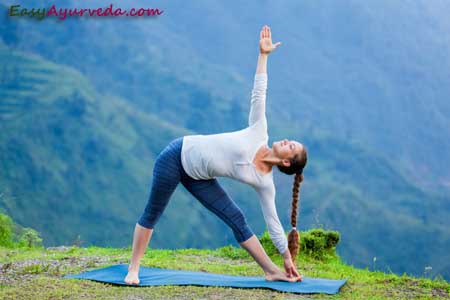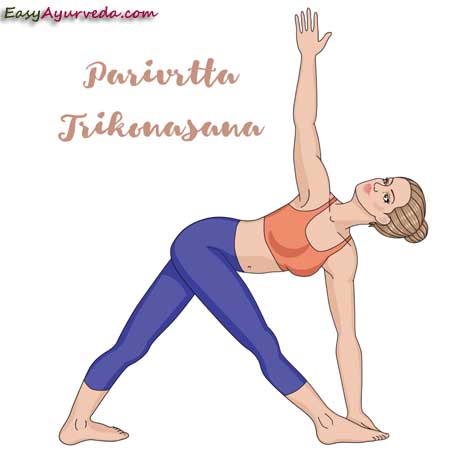Trikonasana Triangle Pose How to do, Benefits, Side Effects

Article by Dr Raghuram Y.S. MD (Ay) & Dr Manasa, B.A.M.S
Trikonasana is an Asana which requires the doer to perform the act or pose in the form of a triangle.
Trikonasana or Triangle Pose
Meaning –
Trikona = Triangle
Asana = Pose, Posture
Table of Contents
Method
Method of doing Trikonasana
Positioning for the Asana
- Stand straight
- Keep your feet apart such that they are separated by a distance of 3.5 to 4 feet
- Turn your left foot inwards, roughly for an angle of 15 degree
- Now turn your right foot outwards by an angle of 90 degree (right angle with the right lower limb or body)
- Align your feet in such a way that the center part of your right heel is in line with center of the arch of your left foot
- Keep your feet pressed against the ground firmly such that your body is equally balanced on both the feet
- Now inhale deeply
Getting to the Triangle pose or Trikona asana
- Now exhale. As you exhale bend your body to the right. Bend at your hips and not at your waist, keep your waist straight as you bend.
- Lift your left hand (upper limb) and allow it to move upward in the air. As you move your left hand upwards, bring your right hand (upper limb) downwards, towards your right foot, towards the ground. Make sure that both your hands are in a straight line.
- Now slowly move your right hand downwards and rest it on your right shin, right foot or on the floor, palms facing down. Do not try to put your hands directly on the floor as it may be difficult in the beginning. As you get expertise over the pose, you can gradually graduate from shin to ankle and later from ankle to floor. If you are flexible enough you can directly floor your right hand. Make sure you don’t shuffle the position of your waist.
- While trying to place the right hand over the floor, point your left hand towards the ceiling, still keeping it in straight line with the right hand. Stretch your left arm in line with top of your shoulder.
- From the neutral position, turn your head gradually towards the left and look upwards towards the tips of the fingers of your left hand or towards the ceiling.
- While doing all these, make sure that your body is bent sideward and not forward or backward. Pelvis and chest should be wide open.
- Stretch to maximum capacity and keep self steady. In the process, keep taking deep and long breaths. Relax the body more and more with each exhalation.
Release from the asana and coming back to the point of start
- As you inhale, gradually come up. Slowly release yourself from the triangular pose. Bring your right hand off ground and slowly rise yourself while bringing the left hand downwards. Bring both your arms down to your sides and assume the position in which you had started.
- Straighten your legs and relax.
Repetition on the opposite side
Now repeat the same steps and repeat the procedure on the opposite side (bending towards left side).

The above said asana is called as Trikonasana because in that pose you look to have taken the shape of a triangle or trikona.
Purva Asanas
Purva Asanas (Preparatory Asanas)
Before Trikonasana, you can do one or more of the below mentioned Asanas –
- Katichakrasana
- Vrikshasana
- Konasana
Paschat Asanas
Paschat Asanas (Post-Trikonasana Poses)
After performing Trikonasana, you can perform Veerabhadrasana
Preparations
Preparation for Trikonasana – Triangle pose
Keep your stomach empty i.e. you need to perform this asana on empty stomach (without having food). There should be at least a gap of 4-6 hours between your meals and the time of performing Trikonasana.
Trikonasana shall be practiced preferably at morning or early morning.
Duration
What time should be spent on each side (after bending to one side)?
Approximately 25-30 seconds should be spent in Trikona pose or position on each side
How many times shall Trikonasan be done in totality?
Trikonasana shall be done for 3-5 times on each leg (towards each side) or depending on one’s capacity
Variations in Trikonasana
Below mentioned variations are related to Trikonasana –
- Baddha Trikonasana – Bound Triangle Pose
- Baddha Parivrtta Trikonasana – Bound Revolved Triangle Pose
- Parivrtta Trikonasana – Revolved Triangle Pose
- Supta Trikonasana – Reclining Triangle Pose
- Utthita Trikonasana – Extended Triangle Pose

Health benefits
Health Benefits of Trikonasana
Below mentioned are the benefits of Trikonasana –
- Provides strength to lower limbs, especially knee joints, legs (calf muscles) and ankle joints
- Provides strength to the arms and chest
- Effectively stretches the spine, shoulders, chest, hips, groins, muscles on the back of your thighs (Hamstrings) and muscles on the back of your legs (calves)
- Enhances the body-mind equilibrium
- Good remedy for stress, anxiety and anxiety related disorders
- Enhances the capacity to digest
- Cures back pain and sciatica
- Good cure for neck pain
- Effective in cases of infertility
- Good remedy for osteoporosis
- Useful therapy for flat foot
- It wards of the instability, loss of expansion and un-evenness in the lower limbs, provides strength to legs and feet and helps expand the torso
Impact on Chakras
Impact of Trikonasana on Chakras
Trikonasana will have a stimulating and balancing effect on Manipura Chakra (3rd Chakra) which is body’s energy and vitality center. Its activation balances the metabolism and belly fire, dispels fear and insecurity.
Who should not do?
Patients suffering from below mentioned conditions should avoid doing Trikonasana –
- Migraine headache
- Diarrhea
- Hypertension (high blood pressure)
- Neck injury
- Back injuries
Effect on Doshas
Effect of Trikonasana on Doshas and their subtypes
Balances and activates the functions of Samana Vayu and Pachaka Pitta – By balancing and activating the functions of Samana Vayu and Pachaka Pitta, Trikonasana enhances digestion and metabolism. It strengthens the digestive organs. This also happens because Trikonasana activates and stimulates Manipura Chakra which is primarily concerned with balancing the metabolism.
Balances Prana Vayu functions – By balancing Prana Vayu and Udana Vayu functions and bringing about their equilibrium and synchronization, Trikonasana brings about body-mind equilibrium. It provides good relaxation from stress and is an effective remedy for anxiety.
Effect on Dhatus
Effect of Trikonasana on Dhatus
Strengthens the asthi dhatu – Trikonasana strengthens the Asthi dhatu (bone) and Asthi Sandhis (bony joints) including knee, ankle, shoulder, hip joints and vertebral joints. It helps cure bone pain and osteoporosis.
Strengthens and tones the Mamsa Dhatu – Trikonasana strengthens the Mamsa Dhatu or muscle tissue including the muscles of the upper limb, chest, groin, thighs and legs. It provides flexibility of limbs and spine.
Just Before Finish
Trikonasana is one of the useful asanas which stretches and strengthens your lower limbs, upper limbs and torso apart from relaxing your mind and curing you of your sciatica. In this article I have touched upon the details of doing Trikonasana along with its benefits on body-mind health.
Click to Consult Dr Raghuram Y.S. MD (Ayu) – skype /email









2 comments
zubesky
Sir any asana to reduce belly fat?
Dr J V Hebbar MD(Ayu)Author
Tadasana (Mountain Pose)
Surya Namaskar (Sun Salutation)
Padahastasana (Standing Forward Bend)
Paschimottanasana (Seated Forward Bend)
Pavanamuktasana (Wind Relieving Pose)
Naukasana (Boat Pose)
Ushtrasana (Camel Pose)
Uttanpadasana (Raised Foot Pose)